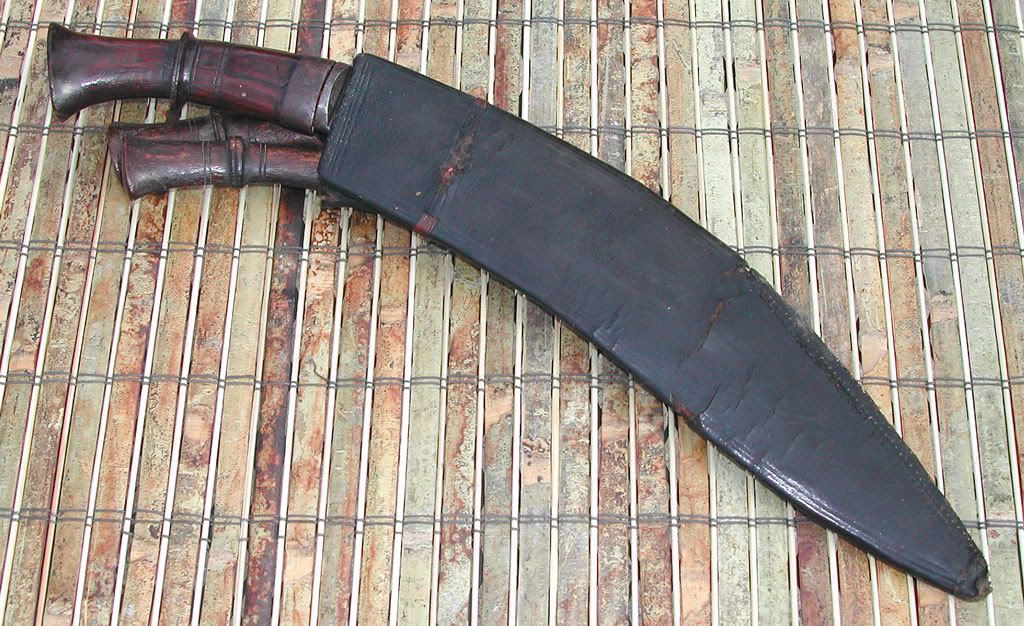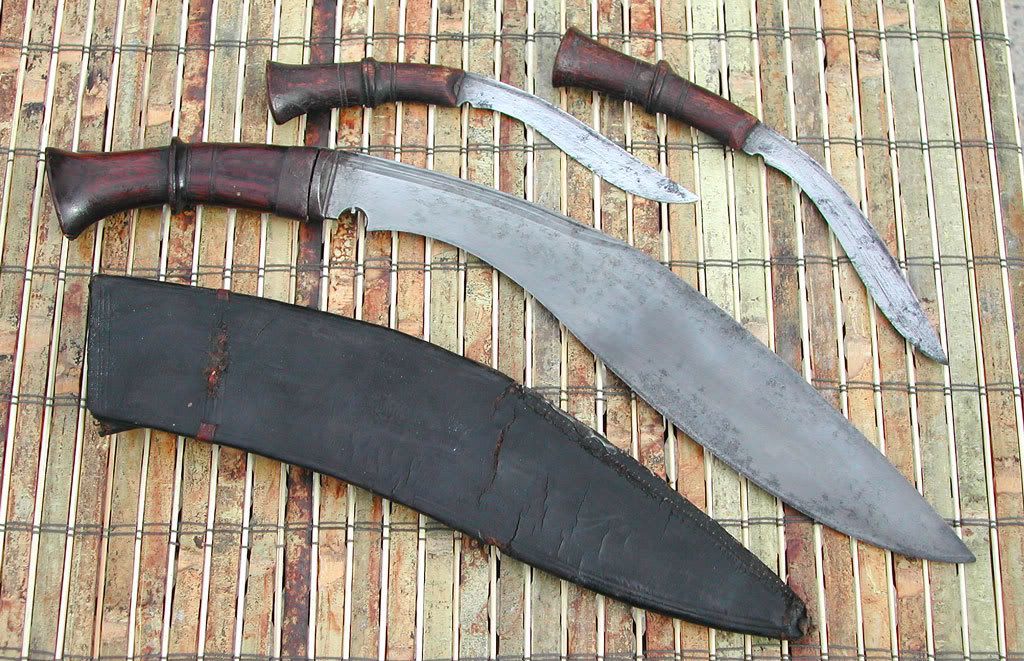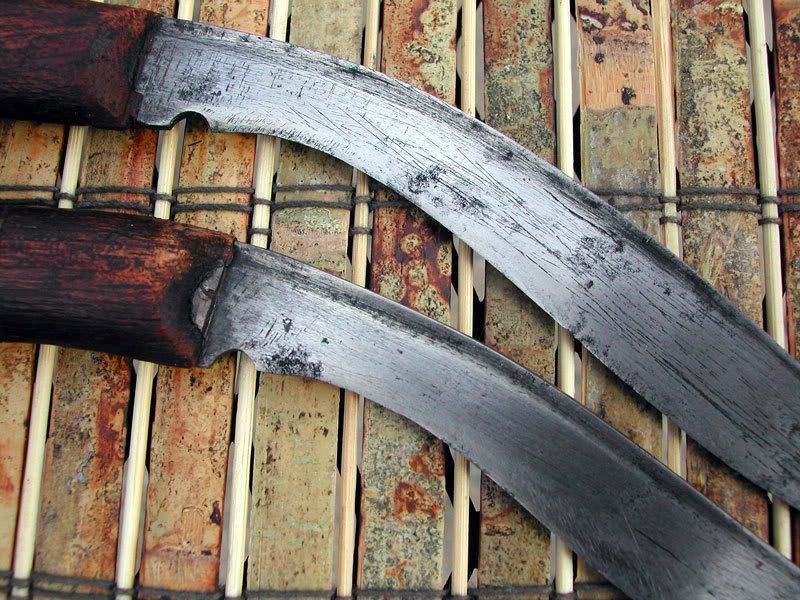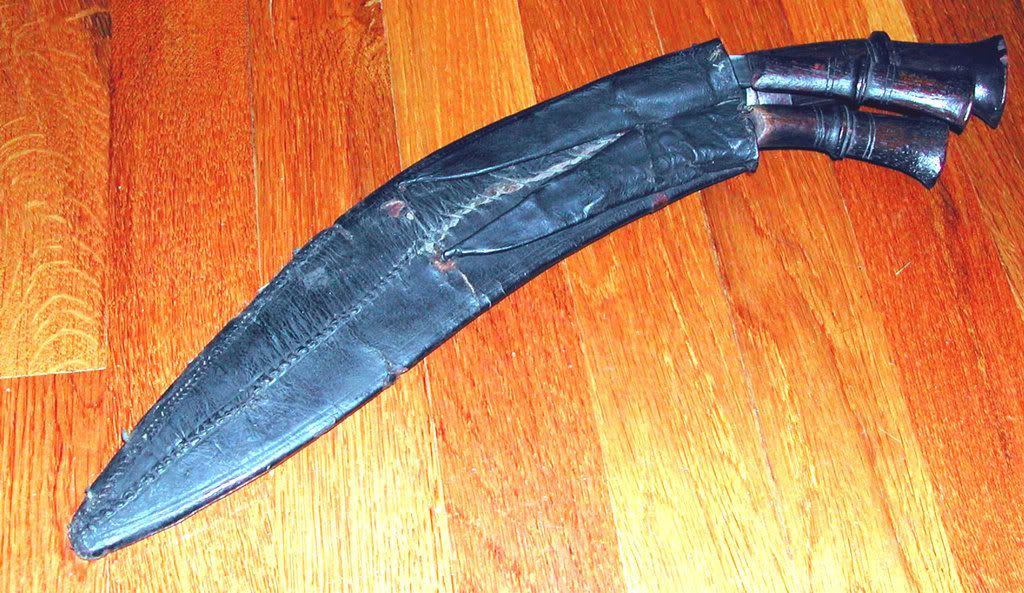
 |
|
|
#1 |
|
Member
Join Date: Dec 2004
Location: Kernersville, NC, USA
Posts: 793
|
I found this old fellow on Ebay, and was intrigued by the kardas. Their curve and length was so graceful. The khukuri is 16.5" long and weighs about 12 oz. The spine is .280" (7.1mm) thick. The kardas are 7 3/4, and 8 1/2" long. There's an interesting repair behind the bolster. A band of iron or steel circles the handle, with a pin through the tang. Thought you folks might enjoy it.
Thanks for looking, Steve     
|
|
|

|
|
|
#2 |
|
Member
Join Date: Jun 2006
Posts: 179
|
The Kardas are interesting. Do you have a picture of the other side of the scabbard?
|
|
|

|
|
|
#3 |
|
Member
Join Date: Feb 2005
Location: England
Posts: 373
|
Hello Steve, I would say pre-WWI, the handle looks to be partial tang? with the pin put in to strengthen it. Its not issue, my guess is that it was made for an Officer either British or Nepali. Anyway its a very nice peice to have
 I would say the pin was probably done by one of the regimental armourers. |
|
|

|
|
|
#4 |
|
Member
Join Date: Dec 2004
Location: Kernersville, NC, USA
Posts: 793
|
Dhadha, I'll snap a pic tonight. There are just 2 leather tubes sewn on to the back of the scabbard for the karda. In poor condition, I'm afraid. There was a thin leather band around the scabbard probably with 2 buttons on front, now gone.
Thanks Simon. Pre WWI? That's great. Better than I hoped. Yes, it's partial tang. Steve |
|
|

|
|
|
#5 |
|
Member
Join Date: Jun 2006
Posts: 179
|
Hey Steve. No hurry for the pic. The Kardas are of a style I've seen on some very early Kukris. So I was wondering if it might have been a later marriage. But the wood looks the similar, if not the same as the Kukri's hilt. And the kukri seems to be of a high quality as well as the Kardas. Besides another, more informed, member has already confirmed the early date of the piece.
I'd still like to see more pics if you get them though. 
|
|
|

|
|
|
#6 |
|
Member
Join Date: Dec 2004
Location: Kernersville, NC, USA
Posts: 793
|
Almost forgot. Here's the back of the scabbard.
Steve 
|
|
|

|
|
|
#7 |
|
Member
Join Date: Jun 2006
Posts: 179
|
Thanks. Great old Kukri, I think.
|
|
|

|
|
|
#8 |
|
Member
Join Date: Dec 2004
Posts: 58
|
A very nice and EARLY piece. congratulations. Rod
|
|
|

|
|
|
#9 |
|
Member
Join Date: Dec 2004
Location: Kernersville, NC, USA
Posts: 793
|
Great news! Thanks gentlemen.
Steve |
|
|

|
|
|
#10 |
|
Member
Join Date: Dec 2004
Posts: 1,712
|
Great old kukri Steve, could be late Victorean or even very early 20th century I think, The karda blades are in a very old style though.
The fat rivet looks very western repair to me, Armourers & Kami normaly just whittle a new handle, rather than drilling through the rat tail tang such a large diameter hole. I think someone loved this one enough to repair it once it had been picked up from its original keeper. But of course we will never realy know. Thanks for sharing this old warhorse with us! I am sure it deserves its well earned retirment. Spiral |
|
|

|
|
|
#11 |
|
Member
Join Date: Feb 2005
Location: England
Posts: 373
|
The kukri is partial tang Jonathan, and armourers often repaired kukri, also the repair looks almost as old as the original bolster to me.
|
|
|

|
|
|
#12 |
|
Member
Join Date: Jan 2007
Posts: 803
|
Very nice kukri Steve.
Does it have a cap on the pommel? If so, how it attached? Thanks for showing it! Richard. |
|
|

|
|
|
#13 |
|
Member
Join Date: Feb 2005
Location: England
Posts: 373
|
Hello Richard, it is a partial tang kukri which generally don't come with butt caps, which is the case here. However some do, and they are often nailed or screwed on.
|
|
|

|
|
|
#14 |
|
Member
Join Date: Jan 2007
Posts: 803
|
Thank you Sir.
I couldn't see a cap, but am new to kukris and am just getting to understand them and the terms. To my eye this one looks a lovely example! Richard. |
|
|

|
|
|
#15 |
|
Member
Join Date: Feb 2005
Location: England
Posts: 373
|
It most certainley is Richard

|
|
|

|
|
|
#16 |
|
Member
Join Date: Jan 2007
Posts: 803
|
Sirupate,
Would it be hi-jacking Steve's thread to ask a Q. re hilts? Were the pommel-caps attached with screws ever used on military pieces? I understand that the rat-tail tang with nut was used on the Mk 1's, and full tang later, so where in the scheme of things does the butt-cap attached with screws fir in? I gather on pieces made by Kamis for local use, butt-caps weren't often fitted at all. Does this still apply now? If I should have started a new thread, I beg pardon! Richard. |
|
|

|
|
|
#17 | |
|
Member
Join Date: Dec 2004
Posts: 1,712
|
Quote:
Heres a MK1 tang.  Lots More mk.1 variations to be seen in my post on this thread at IKRHS. linky Spiral |
|
|
|

|
|
|
#18 |
|
Member
Join Date: Feb 2005
Location: England
Posts: 373
|
Hello Richard,
On some old partial tang kukri, they had butt caps put on to protect the butt, and these were often screwed on. In Spirals picture, the Mk1's had a stick tang, which was attached by a sunken nut into the the top of the butt. Also some Indian Army (British run) quarter master issue kukri in WWI not only had the stick tang peened over the butt plate, but either side were two screws to help secure the butt plate, this was also done with nails. Partial tang kukri are still made in abundance in Nepal, along with stick tang, the least favoured handle type for use in Nepal is the full tang, I hope this helps, cheers Simon |
|
|

|
|
|
#19 |
|
Member
Join Date: Jan 2007
Posts: 803
|
Thank you very much for your answers.
Jonathan, Thanks for picture of the tang, and the link! It will be very interesting to see the variations. I will have a dekko at it ASAP. Simon, Thank you for the explanation of partial tangs and butt-caps. My reason for asking about these, is I just purchased an old kukri with a butt-cap attached with two screws, (No riveted tang) It hasn't arrived here yet, but was interested to know a little about what I had! Also, Very interesting to hear which tang type is least favoured in nepal. Are full tangs more prone to be 'inert'? Steve, Apologies fro using your thread to ask questions. I will start a new one in the future! Richard. Last edited by Pukka Bundook; 28th March 2009 at 05:16 AM. |
|
|

|
|
|
#20 |
|
Member
Join Date: Dec 2004
Posts: 1,712
|
Warren ,Full tangs increase vibration on impact & effect balance unless they are tapered to become thinner towards buttplate.
mk.1,2 & 3 British Indian pattern issue kukri never had buttplate screwed on. Private purchase & company or regimental made or purchased kukri could have. spiral |
|
|

|
|
|
#21 |
|
Member
Join Date: Feb 2005
Location: England
Posts: 373
|
Full tangs have to have exactly the right contours to get the correct action for when using the kukri. This is a problem the W/S kukri had, along with many MKIII's, also when the slab of horn or wood looses its shape, it can lead to rust on the tang, and because the slabs are no longer flush to the tang, it can make the handle uncomfortable, plus that extra shock of the cut comming back into the hand.
It makes no difference to the shock in the hand felt whether the tang is tapered towards the butt or not (W/S kukri had full length and width tangs), what that does do though is give it a different weight ratio and feel in the hand. Below is an example of Indian Army Gurkha Issue kukri, butt plate with screws WWI  I hope that is of help, cheers Simon Last edited by sirupate; 28th March 2009 at 12:49 PM. |
|
|

|
|
|
#22 |
|
Member
Join Date: Jan 2007
Posts: 803
|
Thank you again for answering my Q's, and for attaching the picture Simon.
what you say about full-tangs and stick tangs makes sense. Thinking about this, it came to me how my old 1915 billhook, and our old turnip snaggers we brought with us from England, all have a long tapered tang that passes through the wooden handle, and they have never been any problem, yet have seen tons of work. I think if they were full tang, they would lose a lot of momentum. Steve, I will not clog up your thread with any more stuff! Best, Richard. |
|
|

|
|
|
#23 |
|
Member
Join Date: Dec 2004
Location: Kernersville, NC, USA
Posts: 793
|
Richard, Thread veer is welcome! Glad to see a discussion change and grow.
Steve |
|
|

|
|
|
#24 |
|
Member
Join Date: Feb 2005
Location: England
Posts: 373
|
A pleasure to help Richard, personely I think full tang, especially on kukri is rather overated, and stick tang gives a much better balance.
Steve many thanks 
|
|
|

|
|
|
#25 |
|
Member
Join Date: Nov 2010
Posts: 129
|
Hi
Recently joined the forum, and trawling through some old blogs... My area of expertise is the billhook, and as a working tool, as well as a weapon, I class a khukri as a form of billhook (note many other types of curved billhooks and sickles also exist in Nepal as well as the more commonly known 'military' khukri). The terms full and partial tang occur above as well as tapered tang... For billhooks the most common method of fitting is the full length, tapered tang, with the end bent over at the butt of the handle, or better still rivetted over a washer. Socketed handles, for a wooden insert, and scale tang handles are also found - as are socket handles where no wooden insert is used - and materials other than wood, e.g. antler, horn, bone, leather, are used. In Japan the common method is a partial tang, about half the length of the handle with one or two lateral rivets, and an iron ferrule... Cheap imported billhooks, from India and China, often have a short tang with a lateral rivet passing through the ferrule. In most countries the use of a metal ferrule to prevent the handle splitting is common when a tang is used - handles without are less common, and khukris (with a knife type of bolster on the shoulder of the blade) would appear to be an exception. In other countries when a ferrule is not fitted, the handle often thickens at the entry point to strengthen it.. If there is no tang passing through the handle, there must me some method of preventing the handle coming off in use - sometimes they are glued on with resin, occasionally barbed to dig into the wood - but a lateral rivet is most common. The fitting of a ferrule and a rivet is thus a common method of fitting a handle, and although uncommon on a khukri, would seem an original feature, rather than a later repair. I guess as in most other countries, regional variations in blade profile, thickness, type of handle etc of nepalese khukris, especially pre standardisation of manufacture would not be as uncommon as it seems... Note in the UK, France and Italy hundreds of regional variations in shape of billhook blades are found, often available in range of sizes - in a 1930's catalogue, one French maker, Talabot, boasted they held patterns for over 3000 shapes, and would make any other upon receipt of a paper template... |
|
|

|
|
|
#26 |
|
Member
Join Date: Dec 2004
Posts: 1,712
|
Thanks for your wisdom on Billhooks Billman.
I agree some kukris have a single rivet through the ferrule generaly termed a bolster, but I am sure that If the ferrule on the featured kukri was originaly part of the kukri it would match the size of the bolster for a start. Also In India & Nepal if they wished to support the handle further they would just make a longer bolster {Which is just a capped ferrule after all.} with that where the strength would lie after all not an illmatched double ferrule construction. As an aside but perhaps slighty related. I should also point out to anyone thinking of repairing a kukri that a single rivet can also break a rosewood or similar handle on a partial tang handle if placed outside of a ferrule, after all it creates a pressure point where the force is concentrated as the rivit operates as a pivot point. Spiral |
|
|

|
|
|
#27 |
|
Member
Join Date: Nov 2010
Posts: 129
|
Thanks for your response Spiral - khukri are not my area of expertise, so I always bow to greater knowledge - but my experience of billhooks from many lands has shown me nothing is set in stone, and there are always variations and exceptions to rules....
Since posting the previous reply I have found a little more on the Nepaese sickle, or aansi. The same name refers to both a light small rice sickle and also a heavier billhook for wood. It is a more common, and more widespread, tool in Nepal than the celberated khukri - and there are many regional variations... I would argue that a capped ferrule is not the same as a bolster - the bolster is integral with the blade, the ferrule - capped or open - is part of the handle, to prevent it splitting when pressure is put on the tang.. The bolster acts as a shoulder to stop the handle progressing up the blade - on the sickles, a shoulder is sometimes formed by bending the blade at right angles.. |
|
|

|
|
|
#28 | |||
|
Member
Join Date: Dec 2004
Posts: 1,712
|
Quote:
Quote:
 Funny that your research includes feature the first picture, One I took 6 years ago during a visit to Nepal to research kukri, kora & other bladed items, some of which I also watched bieng made. There are many variations both in the design of all these tools & also thier names, Hansiya is another common name for Sickle also. Funny that your research includes feature the first picture, One I took 6 years ago during a visit to Nepal to research kukri, kora & other bladed items, some of which I also watched bieng made. There are many variations both in the design of all these tools & also thier names, Hansiya is another common name for Sickle also.in the last decade they are probably seen in Nepal more than kukri as since the most violent part of the recent insurgency/revolution kukri were banned from carry in many areas. Traditionaly though many poor housholds would only own one tool & it was the kukri which will do the job of a sickle or billhook after all. Quote:
1, ferrules & bolsters are both used to strengthen the handle/hilt, although the bolster also protects the end grain & provides a smooth junction between hilt & blade. 2, Some ww2 era kukri did have an integral welded bolster together with a full width tang double riveted, but this is unusual most bolsters are a rolled single piece of sheet metal folded & filed to form the bolster. 3, partial & rat tail tangs on kuhukri a built with a stepped shoulder so it is impossible for the hilt to proggress up the blade.After all The word bolster mans to add support & strength, not to prevent movement. 4, Also as an aside both this hook. {from my photo....} & this one, are actualy capped ferrules{ Otherwise known as bolsters.} Possibly some of the others are as well. I suggest you buy a few kukri & hansiya & dismantle them where neccasary if you realy want to see what kukri tangs & bolsters are like. Its an intersting study I am sure you would enjoy. I cartanly have & Ive only ever owned around 700 kukri although Ive seen & handled thousands more off course. Mostly from around c.1800 to 1945 both military,traditional & presentation pieces. Spiral |
|||
|
|

|
 |
|
|